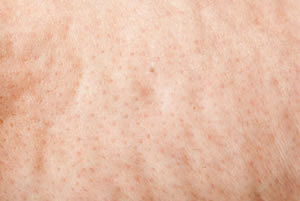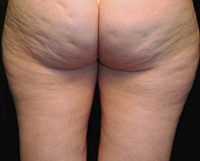
Cellulite
What is cellulite?
Causes of cellulite
Prevention / remedies / treatment for cellulite
References
What is cellulite?
Cellulite (orange peel skin, cottage cheese skin, adiposis edematosa, dermopanniculosis deformans, status protrusus cutis, gynoid lipodystrophy) occurs when the fibrous connective tissue under the skin breaks down and portions of subcutaneous fat bulge through. It shows up as dimples and nodules on the skin surface. The connective tissue in the dermis tends to break down, and fat lobes and fat cells in the dermis bulge upward under the epidermis.
Cellulite is usually located in the pelvic region, abdomen and upper legs, though it can also occur on the arms and other parts of the body.

Cellulite occurs in 80-90% of post-puberty women. However, it is rarely seen in men.
Most doctors consider cellulite as a normal condition for adult women. It is a condition that is difficult to treat, and a study (1) found that no treatment is completely successful and none are more than mildly and temporarily effective. Most skin specialists agree that there is no definitive treatment for cellulite. Nevertheless, there are many treatments offered on the internet including radiofrequency, laser and light-based treatments; invasive modalities including liposuction, mesotherapy (injections of pharmaceutical and homeopathic medications, plant extracts, vitamins, and other ingredients into subcutaneous fat), and subcision (surgically separating the skin from the affected area); and other treatments including topical creams, massage and carboxy therapy.
Causes of cellulite

- Copper deficiency.
- Hormonal. Cellulite is common in most women, but is rarely seen in men except those men with an androgen-deficient
state. Men who are receiving estrogen therapy for prostate cancer, or those with Klinefelter's syndrome, hypogonadism, or those who
are castrated tend to have more cellulite.
Estrogen may be the most important hormone to initiate and aggravate cellulite, but there are no reliable studies to support this. Other hormones, particularly insulin, may also be involved in the development of cellulite. (3) - Genetic factors. (2, 3)
- Poor lymphatic and blood circulation. (3)
- Inflammatory conditions.
- Dieting too hard and too much. (2)
- Continual excessively-high stress lifestyle.
Prevention / remedies / treatment for cellulite
- Diet. Eat a high-nutrient diet that provides the raw materials to rebuild the damaged connective tissue in the dermis. The most important element for the production of connective tissue is copper. This includes eating the fat, skin, organs (especially liver, which is the richest food source of copper) and connective tissues of animals. This is not as bad as it sounds. In past centuries, our ancestors wasted very little of any animal, but today supermarkets tend to sell lean meat and discard everything else. Traditional recipes make use of bones, gristle and skin to make beautiful stocks and other dishes. The Grow Youthful Recipe Book shows you how to do it.
- Fat reduction. It is a physiological fact that women generally have more dermic fat than men. Loss of this underskin fat will help reduce the fat bulging through the skin hernias. You lose this fat NOT by dieting, but by continuing with a low carbohydrate diet for life.
- Coconut oil.
- See details of remedies recommended by Grow Youthful visitors, and their experience with them.
References
1. Wanner M, Avram M.
An evidence-based assessment of treatments for cellulite.
J Drugs Dermatol. 2008 Apr;7(4):341-5.
2. Pavicic T, Borelli C, Korting HC.
Cellulite - the greatest skin problem in healthy people? An approach. (in German).
October 2006, J Dtsch Dermatol Ges 4 (10): 861-70.
3. Rossi AB, Vergnanini AL.
Cellulite: a review.
July 2000, J Eur Acad Dermatol Venereol 14 (4): 251-62.
